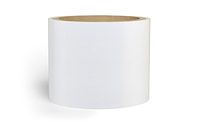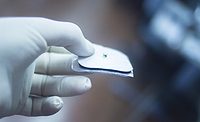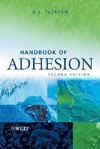How Acrylic Tapes Are Transforming the Future of Wearable Medical Devices
From glucose and heart monitoring devices to defibrillator systems and beyond, more people are wearing devices that provide essential information to their doctors.

Image courtesy of Mactac North America.
Wearable medical devices are becoming increasingly common as the U.S. population lives longer. According to Deloitte US, 320 million consumer health and wellness wearable devices were shipped worldwide in 2022, and projections suggest this number could reach nearly 440 million by 2024. From glucose and heart monitoring devices to defibrillator systems and beyond, more people are wearing devices that provide essential information to their doctors, which improves the quality of their lives.
Though wearables are as varied as the number of conditions they monitor, they all have one thing in common: they all need adhesives to attach to the skin. Those adhesives must be able to withstand the rigors of regular living, whether they are being used in a clinical study or out in the real world.
For short-term applications like water-proof bandages, rubber adhesives work just fine. As the length of wearable time extends, however, it’s important to use an adhesive that offers breathability, flexibility and durability. Additionally, finding the right adhesive that can attach to different skins — what feels good for one person may not be as comfortable for someone else — can be a particular challenge.
Fortunately, manufacturers have worked hard to find adhesives to fit this important role. Acrylic adhesives are becoming increasingly popular for this application. Not only are they versatile enough for use in different applications, manufacturing them has fewer long-term environmental effects.
In this article we will discuss why acrylic adhesives are the best choice for wearable and long-term wear applications.
Acrylics Are Better for the Patient
Unlike other adhesive options, acrylic adhesives don’t irritate the skin and cause sensitivity in the area being covered. This is particularly important in geriatric and pediatric settings, where the patients are more sensitive to the painful removal of tapes. Acrylic adhesives create an ideal situation for medical devices that come directly in contact with the skin, such as wearable sensors, drug delivery systems, and medical tapes.
Additionally, wearable devices are no longer as temporary as they once were. In some cases, they must remain on for extended periods of time, either to deliver medication effectively or monitor vital health measures like heart rate, pulse, and blood-oxygen levels. Acrylic adhesives provide strong and durable bonding mechanisms not found in other adhesive options, even as skin flexes and moves.
The difference with acrylics is the tape itself is flexible, making it easier for patients to function effectively as they move through their day.
Enduring Harsh Real-World Conditions
Humidity can wreak havoc on adhesives and cause them to lose their ability to stay in place. Acrylic adhesives, on the other hand, thrive in humid conditions, so they are perfect for long-term wearables that might encounter sweat or exposure to water. Their moisture resistance means devices can stay in place longer, allowing for more accurate diagnostic data and stable drug delivery.
Thanks to their formulations, acrylic adhesives also deal well with environments where temperatures vary widely, and they are also resistant to chemical degradation. In health care applications where devices may need to be sterilized, or in other challenging environmental conditions, acrylic adhesives make the most sense.
Well Versed in Versatility
Manufacturers can produce acrylic adhesives with different degrees of tackiness, thickness and permeability, which makes them adaptable for specific situations. Practically, that means acrylic adhesives are perfect for a wider array of medical devices, ranging from gentle adhesion for sensitive skin to situations where secure bonding is paramount.
In many medical applications, transparency is essential as well. Acrylic adhesives allow doctors and nurses full visibility of the skin and device components. They also allow more sophisticated equipment, like optical sensors, to monitor devices without obstruction.
Acrylic adhesives are simple to use and can come in many shapes and sizes. Whether they’re processed in rolls, sheets, or patches, acrylic adhesives adapt well to multiple applications. In addition, acrylic adhesives may be die-cut into complex shapes and can be tailored to the specific wearable device.
Why Acrylic Adhesives Make Environmental Sense
Some adhesives require solvents to make them stick. Fortunately, acrylic adhesives are often created as water-based adhesives, which lowers VOCs emissions as they are manufactured. VOCs pollute the air and cause health problems, which means any adhesive that can be manufactured without emitting them is a significant environmental win.
Additionally, creating a water-based adhesive can use less energy than their solvent-based counterparts. That's because non-acrylic adhesives often require energy-intensive steps like distillation and other extraction technologies to reduce or eliminate their exposure to the environment. With those steps removed, acrylics cause less environmental damage overall.
Once they are in health care operations, acrylic adhesives protect doctors and nurses more effectively because they are less flammable than other adhesive options. The less volatile acrylic adhesives mean health care facilities can save money because they need less sophisticated safety equipment and controls, which ultimately brings down health care costs for everyone.
Finally, more manufacturers are looking to improve acrylic adhesive technology even further, with the advent of bio-based adhesives. The simplicity of the acrylic adhesive structure makes these innovations possible.
The Bottom Line
Due to their exceptional adherence and other advantages outlined, acrylic adhesives are rapidly becoming the adhesive of choice for wearable medical devices. They are safe for direct skin contact and are less likely to irritate the skin during application and removal. Durable and able to withstand a variety of conditions like severe temperature variations and humidity, they are ideal for wearable devices that must be worn for extended periods of time. Additionally, they are flexible, which means they conform more easily to body contours while remaining in place.
With this impressive number of beneficial properties, acrylic adhesives are quickly becoming part of a high standard of care in U.S. health care facilities. They not only meet the needs of current medical applications, but they also set the stage for more innovations in the future.
For more information on Mactac North America’s medical-grade adhesives, visit www.mactac.com/medical.
Looking for a reprint of this article?
From high-res PDFs to custom plaques, order your copy today!








